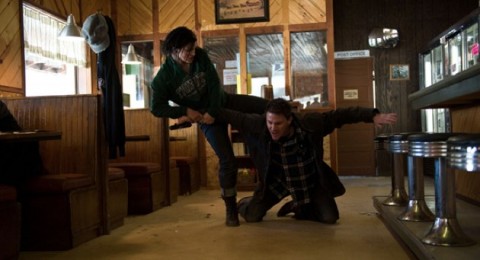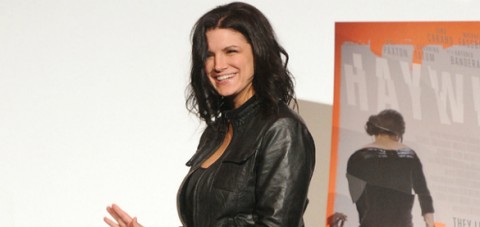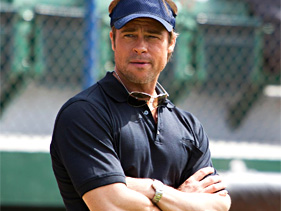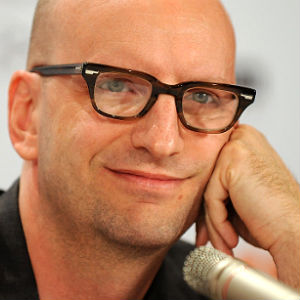One of the most fascinating and intimate moments in Frederick Wiseman’s Crazy Horse , a peek behind the shimmery veil of Paris’s legendary semi-nude cabaret, is the one in which the club’s no-nonsense manager, Andrée Deissenberg, tells a reporter that women find the performances just as compelling as men do, if not more so – that watching this highly orchestrated display of beauty on-stage speaks to them in a way that goes far beyond garden-variety titillation. “The key to eroticism is the woman,” she says flatly, a statement the reporter doesn’t seem to fully agree with, though he at least has the good sense to bow to her authority on the matter. She knows what she’s talking about, and Wiseman clearly does too. For all his intelligence and attention to craft, Wiseman is also among the warmest, the least clinical, of all documentary filmmakers; there’s never any pretense that he’s just turning the camera on and letting it capture reality. His eyes are open every minute, and his mind is awake. The lithe beauties of Crazy Horse may seem an unlikely subject for Wiseman, who’s revered – rightly – for pictures like his debut, the 1967 Titicut Follies, which documented human atrocities at Massachusetts Correctional Institution Bridgewater. More recently, he’s captured the ramshackle camaraderie of boxing enthusiasts in Boxing Gym . And in La Danse, his seemingly casual yet intense observation of the backstage workings at the Paris Opera Ballet, he traced the ways in which the human body, with all its earthbound limitations, can be trained to move in ways that come as close as possible to human perfection. Now, he’s looking at semi-naked women. And what women! Crazy Horse is neither prurient nor titillating, and it’s not out to make a bold statement. (If you’re looking for evidence that some/most/all women who work as erotic dancers are exploited, damaged or in some way compromised, you won’t find it here.) Instead, the picture is celebratory, in its own quiet way, as well as clear-eyed. The Crazy Horse, which has been operating since 1951, is known for dance routines that are lavish, flirtatious, possibly just a little bit tacky, though in an exquisitely French way. Wiseman’s camera is open to all of it, as it is to the grace and vulnerability of the dancers who perform these routines (many of whom have ballet training). It could be that Wiseman, who is now 81, is more attuned than ever to observing and marveling at the wonder of human movement. We already know there’s eroticism in ballet and boxing. The next natural step, maybe, is to find it in a chorus line of beautiful young women wearing modified – and extremely skimpy – Royal Guardsmen’s outfits. Wiseman’s camera, as always, captures the big moments and the small ones: Preparing to go on-stage, a dancer dots her lash line with glue before applying a lush, flirty faux fringe. Late in the picture, we watch an audition in process, and while the focus is on the hopeful young women angling for a job, Wiseman also clues us in to the practical-mindedness of the judges: They may note, among themselves, that one girl’s legs may not be quite as long as they’d like, but there’s always a degree of businesslike kindness at work, too – they try to make their decisions as swiftly as possible, not wanting to prolong a prospective dancer’s hopeful anxiety any longer than necessary. (It’s the exact opposite of what you see on so-called reality TV.) And, as always, Wiseman is acutely aware of the dollars-and-cents reality behind any illusion. He takes us behind the scenes as Deissenberg and the club’s director and choreographer, Philippe Decouflé, wrangle with the economic realities of running the Crazy Horse: At one point Decouflé begs to close the club for a short time, so he can come up with brand-new routines and even just clean the spotlights, which have become grimy and don’t highlight the contours of the women’s bodies as they should. Deissenberg shakes her head, asserting grimly that there’s no way the shareholders would go for it. Artistry, whether in ballet or burlesque, has to find ways to flourish despite economic restrictions. But mostly, Crazy Horse focuses on the dancing, the dancers, and the silly-wonderful nature of the Crazy Horse routines. Wiseman doesn’t focus on any single dancer – the word ensemble is key here – and yet the individual performers still emerge as distinctly human. At one point, as the dancers wait to go on-stage, they gather ‘round a TV to watch a Russian compilation tape of ballet flubs, laughing hysterically as presumably perfect dancers slip, stumble, and otherwise humiliate themselves. At another point, Decouflé discusses a routine, called Venus, that the performers dislike because it requires them to touch each other. “The girls often come out of it in tears,” he says. “They’re modest.” The moment is revealing, and more than a little touching: These women revel, publicly, in the beauty of their bodies, but feel awkward and strange when it comes to touching one another. It’s a boundary of privacy and intimacy that they’d rather not breach. When you see the Crazy Horse routines, this makes sense: We’re not talking about improvised bumping and grinding here (although, of course, in the right setting that can be perfectly OK too). These are meticulously orchestrated numbers in which the illusion of nakedness is more extreme than the actual fact of it. The women are both unsheathed and highly artificial. They might wear Rudi Gernreich-style unitards that consist of little more than a triangle of fabric held up, very helpfully, by two slender straps, leaving the breasts fully exposed. Slatted or polka-dotted lighting effects are often used to highlight specific womanly attributes. It’s worth noting, too, that there’s definitely a Crazy Horse type: We’re not talking about a celebration of all shapes and sizes here. At one point in the picture the dancers don headphones offstage to record a theme song, describing themselves, with marvelous tunelessness, as “the girls of the Crazy.” The girls of the Crazy typically have smallish breasts (not an implant in sight) and glorious, rounded bottoms, which they thrust out at every opportunity – at the Crazy, it’s all about the butt. But what about the dancing? There’s a great deal of physical discipline necessary to pull these routines together, as the rehearsal sequences show. The illusion of eroticism is a harsh taskmistress, and the shoes are killer, too. There’s nothing harder on feet than dancing en pointe , but it can’t be all that easy executing a Cirque du Soleil-style routine, as one dancer does, in a pair of shoes that consist of a Lucite spike heel attached to the bare foot with a few pieces of elastic. Like all dancers, the Crazy Horse performers are aware of the importance of elongating the body. And even if numbers like the one called “Baby Buns” are designed to celebrate certain parts of the anatomy, the reality is that there are a lot of hardworking muscles beneath all those comely attributes. Crazy Horse is a movie about process, about performance, about the exacting nature of producing an exquisite, entertaining sexual illusion. Yet Wiseman isn’t one of those documentarians who can’t see the forest through the trees: The girls of the Crazy are simply beautiful and delightful to look at. Even Wiseman, cerebral, perceptive, and a maestro in the editing room, can’t resist urging us, with images if not with words, “Just look at them!” And so we do. Follow Stephanie Zacharek on Twitter . Follow Movieline on Twitter .
Here is the original post:
REVIEW: No Ifs or Ands, But Lots of Butts in Frederick Wiseman’s Delightful Crazy Horse
































